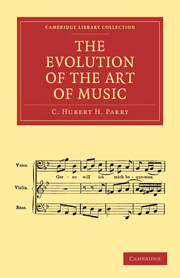Book contents
- Frontmatter
- PREFACE
- Contents
- CHAPTER I PRELIMINARIES
- CHAPTER II SCALES
- CHAPTER III FOLK-MUSIC
- CHAPTER IV INCIPIENT HARMONY
- CHAPTER V THE ERA OF PURE CHORAL MUSIC
- CHAPTER VI THE RISE OF SECULAR MUSIC
- CHAPTER VII COMBINATION OF OLD METHODS AND NEW PRINCIPLES
- CHAPTER VIII CLIMAX OF EARLY INSTRUMENTAL MUSIC
- CHAPTER IX BEGINNINGS OF MODERN INSTRUMENTAL MUSIC
- CHAPTER X THE MIDDLE STAGE OF MODERN OPERA
- CHAPTER XI THE MIDDLE STAGE OF “SONATA” FORM
- CHAPTER XII BALANCE OF EXPRESSION AND DESIGN
- CHAPTER XIII MODERN TENDENCIES
- CHAPTER XIV MODERN PHASES OF OPERA
- SUMMARY AND CONCLUSION
- INDEX
CHAPTER XIII - MODERN TENDENCIES
Published online by Cambridge University Press: 29 August 2010
- Frontmatter
- PREFACE
- Contents
- CHAPTER I PRELIMINARIES
- CHAPTER II SCALES
- CHAPTER III FOLK-MUSIC
- CHAPTER IV INCIPIENT HARMONY
- CHAPTER V THE ERA OF PURE CHORAL MUSIC
- CHAPTER VI THE RISE OF SECULAR MUSIC
- CHAPTER VII COMBINATION OF OLD METHODS AND NEW PRINCIPLES
- CHAPTER VIII CLIMAX OF EARLY INSTRUMENTAL MUSIC
- CHAPTER IX BEGINNINGS OF MODERN INSTRUMENTAL MUSIC
- CHAPTER X THE MIDDLE STAGE OF MODERN OPERA
- CHAPTER XI THE MIDDLE STAGE OF “SONATA” FORM
- CHAPTER XII BALANCE OF EXPRESSION AND DESIGN
- CHAPTER XIII MODERN TENDENCIES
- CHAPTER XIV MODERN PHASES OF OPERA
- SUMMARY AND CONCLUSION
- INDEX
Summary
Beethoven stands just at the turning-point of the ways of modern art, and combines the sum of past human effort in the direction of musical design with the first ripe utterance of the modern impulse–made possible by the great accumulation of artistic resources–in the direction of human expression. After him the course of things naturally changed. In the art of the century before him formality was prominent and expression very restrained ; in the times after him the conditions were reversed, and the instinct of man was impelled to resent the conventions of form which seemed to fetter his imagination, and began his wanderings and experiments anew in the irrepressible conviction that every road must lead somewhere. A new artistic crisis had been passed, similar to the crisis of Palestrina and Bach, but implying a still greater organisation and a richer accumulation of actual resources than was available for either of the earlier masters. All three crises represent a relatively perfect formulation of human feeling. Palestrina without emotion embodies the most perfect presentation of contemplative religious devotion. Bach, more touched by the secular spirit, and fully capable of strong emotion, formulates a more comprehensive and energetic type of religious sentiment, and foreshadows, by his new combination of rhythm and polyphony, the musical expression of every kind of human feeling.
- Type
- Chapter
- Information
- The Evolution of the Art of Music , pp. 273 - 305Publisher: Cambridge University PressPrint publication year: 2009First published in: 1896



